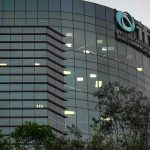South Korea, the most technologically advanced country on the planet, is going through a complex stage. The siege by North Korea, which continually fires its missiles to show its strength, is compounded by pressure from China and the United States, which covet its latest-generation chips.
“When the whales fight, the shrimp have a broken back,” South Koreans tend to comment when asked about the evolution of their country. The proverb refers to the suffering that South Korea has suffered throughout history due to the wars waged by the empires of Russia, China and Japan on its territory, but today it is still on people’s lips, aware that the future of the country is not in your hands alone. It depends on an uncontrollable neighbor, North Korea, and two superpowers, China and the United States, courting South Korea for its technological power.
South Koreans are certainly not used to conveying optimism about the progress of their country. The reality, however, shows that the tenth economic power on the planet has fared better than others from the coronavirus pandemic and its economic evolution is better than that of many other countries. So far, it has recorded 29,800 deaths from Covid, compared to the 115,000 deaths registered in Spain, when both countries have very similar population figures, since the South Koreans add up to 51.7 million and the Spanish, 47.4 million. And the economic prospects are not bad: last year the GDP grew by 4% and for this year the IMF expects it to grow by 2.6%, despite the effects of the war in Ukraine and the rigid Chinese policy of Covid zero, which alters the global supply chain.
The health of the South Korean economy, which has been generating employment for 20 months in a row and has unemployment at 2.4%, is due to a combination of factors that have made the country a leader in technology, industry and education. A leading position achieved thanks to close collaboration between the government and large private industrial groups. Cooperation that has resulted in the strong development of cutting-edge technology, the registration of patents and huge investments in research, development and innovation, which account for 4.8% of its GDP, compared to 3.09% in Germany or 1.41 % from Spain. An effort that has turned South Korea into the tenth world economy and the fourth regional power, after China, Japan and India, with a per capita income of $29,576.
However, this “miracle of the Han River” – as local economists define the South Korean economic explosion due to the vitality that is reflected around the river that runs through Seoul, the city that embodies the country’s modernity – is not only due to the investments made by large groups such as Samsung, which represents 20% of the country’s GDP. They also attribute it to South Koreans’ spirit of overcoming. “Education, organizational capacity and the hierarchy of its society are fundamental to the success of the country,” says a veteran Spanish diplomat. A reality confirmed by the Spanish president, Pedro Sánchez, during his visit to Seoul, on November 17, to attract investment in semiconductors.
But not everything is going smoothly in a country whose fertility rate is the lowest in the world, the minimum interprofessional salary is 1,422 euros and the average salary is around 2,800 euros. The government of the conservative Yoon Suk-yeol is in low hours. His popularity has fallen to 34% due to a series of errors, derived from his political inexperience, after serving as a prosecutor for the last 27 years.
Yoon’s problems accumulate and his foreign agenda becomes complicated. The death of 156 young people in a bustling Seoul neighborhood on Halloween night by a stampede and the slow reaction of the rescue teams have generated a wave of indignation among the population, which demands answers from its president. An irritation that is added to the social unrest caused by the increase in inflation, which in October was 5.7%, and the uncertainty about the future of the semiconductor industry, one of the leading sectors in the country and whose fate is in jeopardy. the eaves due to pressure from the US so that it does not sell its most sophisticated products to China.
It is precisely in the foreign agenda where South Korea has the most complex challenges, with the aggravating circumstance that North Korea has opted to harden its position and launch ballistic missiles as it had not done in recent times. Yoon had proposed to break the subtle balance that Seoul maintained with the two superpowers and join the US Indo-Pacific strategy, in addition to improving dialogue with Japan. But the stake is not simple.
His big bet is high voltage, given the tension surrounding the current relations between China and the US and South Korea’s technological leadership. From day one, Yoon has posed as a pro-Washington hawk on Beijing, but reality is making him recap. The Asian giant is South Korea’s main trading partner and he has already let him know this, warning him there will be retaliation if he installs a second US THAAD anti-missile shield to defend against North Korean missiles.
But the real problem for Yoon is in the semiconductor battle. Washington is pressuring Seoul to join the “Chip 4” alliance, a White House initiative aimed at ensuring cooperation in the production of sophisticated semiconductors between the US, Japan, Taiwan and South Korea, and thwarting the ability of Chinese industry to improve its competitiveness. Washington has given a one-year moratorium to Seoul to end its sales to China, which in 2021 amounted to 523,000 million dollars and account for 40% of the country’s chip exports, with the consequent economic impact. A hard pill to swallow for South Korean manufacturers, who are heavily dependent on Chinese components and unwilling to lose such a valuable market.
Once again, the South Korean shrimp is in danger due to the fight between whales.









